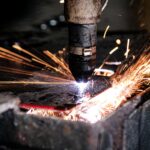As a car enthusiast or a dedicated DIY auto buff, you know that maintaining the aesthetic appeal of your vehicle is just as important as ensuring its mechanical functionality.
One of the most common issues you’ll face is dealing with paint damage from minor scratches to more extensive chipping or peeling.
Repairing automotive paint may seem daunting, but with the right tools and techniques, it’s a skill that can be mastered from the comfort of your garage.
In this comprehensive guide, we’ll walk you through the essential steps and provide expert tips to help you achieve professional-quality paint repairs on your vehicle.
Understanding Automotive Paint Damage
Before diving into the repair process, it’s crucial to understand the different types of paint damage you might encounter:
Types of Paint Damage
- Scratches: These are usually superficial marks caused by minor abrasions. They are classified into three levels:
- Clear Coat Scratches: Affect only the top layer of the paint.
- Base Coat Scratches: Penetrate through the clear coat into the color layer.
- Primer Scratches: Extend through the clear coat and base coat down to the primer.
- Stone Chips: Tiny spots where rocks or debris have chipped away the paint.
- Oxidation: A chalky residue that forms on the paint surface due to prolonged exposure to the elements, typically seen on older cars.
- Peeling: This happens when the clear coat separates from the base coat, often due to poor initial application or prolonged UV exposure.
- Essential Tools and Materials
- To tackle paint repairs effectively, you’ll need the following tools and materials:
- Sandpaper (various grits ranging from 600 to 2000)
- Auto body filler (for deeper scratches and dents)
- Primer
- Automotive paint (matching your vehicle’s color code)
- Clear coat
- Masking tape and paper (to protect areas around the repair site)
- Polishing compound and wax
- Spray gun or paint pens (for small touch-ups)
- Microfiber cloths
- Personal protective equipment (gloves, masks)
- Step-by-Step Repair Process
1. Assess the Damage
Start by thoroughly cleaning the damaged area with soap and water, then drying it off. This will help you accurately assess the extent of the damage.
2. Prepare the Surface
For minor scratches:
- Lightly sand the scratch with fine-grit sandpaper (e.g., 1500-2000 grit) to smooth the edges.
- Clean the sanded area with rubbing alcohol to remove dust and oils.
- For deeper scratches or chips:
- Sand the area with coarser grit sandpaper (e.g., 600-800 grit) until the edges of the scratch/chip are level with the surrounding paint.
- If necessary, apply auto body filler to fill in any depressions, then sand it smooth once it hardens.
3. Mask Off Surrounding Areas
Use masking tape and paper to protect areas adjacent to the repair site. This ensures you don’t accidentally spray paint on undamaged parts of the car.
4. Apply Primer
Spray a light coat of primer over the sanded area. Hold the spray can or gun about 6-8 inches from the surface and use smooth, sweeping motions.
- Let the primer dry according to the manufacturer’s instructions, then sand lightly with fine-grit sandpaper to ensure a smooth surface.
- 5. Apply Automotive Paint
- Using your vehicle’s color code, apply the matching paint in thin, even layers. Allow each layer to dry before applying the next. This may require multiple coats to achieve a uniform color match.
- Blend the edges of the painted area with the surrounding paint to avoid noticeable transitions.
- 6. Apply Clear Coat
- Once the paint has dried completely, apply a clear coat in the same manner, using thin, even coats.
- Allow the clear coat to dry thoroughly, then wet sand with ultra-fine sandpaper (e.g., 2000 grit) to smooth out any imperfections.
- 7. Polish and Wax
- Use a quality polishing compound to restore the shine and blend the repaired area with the original paint.
- Finish with a layer of wax to protect the paint and give your car a glossy finish.
- Pro Tips for a Flawless Finish
- Work in a dust-free environment: This prevents particles from contaminating the paint.
- Temperature matters: Avoid painting in extreme temperatures. Ideal conditions are between 60°F and 80°F with low humidity.
- Patience is key: Rushing the process can lead to errors. Allow each layer (primer, paint, clear coat) to dry thoroughly before moving on to the next step.
- Practice makes perfect: If you’re new to paint repair, practice on a small, inconspicuous area or an old panel before tackling larger, more visible sections.
Conclusion
Repairing automotive paint can be a challenging task, but with the right tools and approach, it’s a job that any car enthusiast or DIY auto buff can handle.
Using an ARPShop paint spray gun, you can achieve a professional finish and transform your car’s appearance.
Whether you’re fixing a small scratch or a more extensive repair, the key is to take your time and be meticulous in your work. With patience and attention to detail, you can restore your vehicle’s paint to its former glory and have a sense of pride in your impressive handiwork.
Remember, the devil is in the details, and a well-executed paint repair can make all the difference in the appearance and value of your beloved vehicle. So roll up your sleeves, gather your tools, and let’s get to work!
For more automotive tips and DIY guides, be sure to follow our blog and share your own experiences in the comments below. Happy wrenching!





